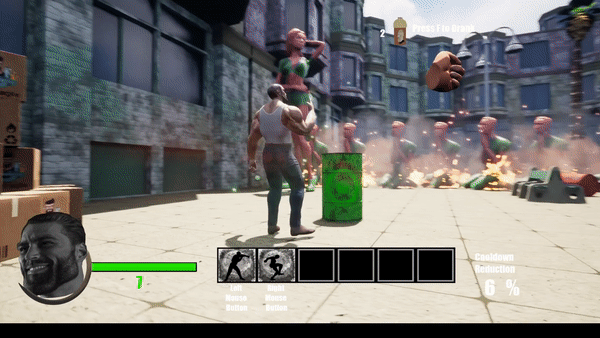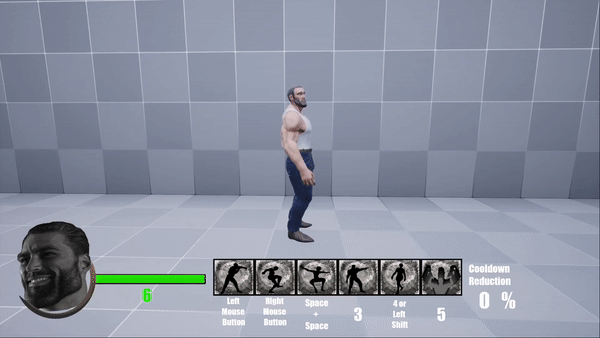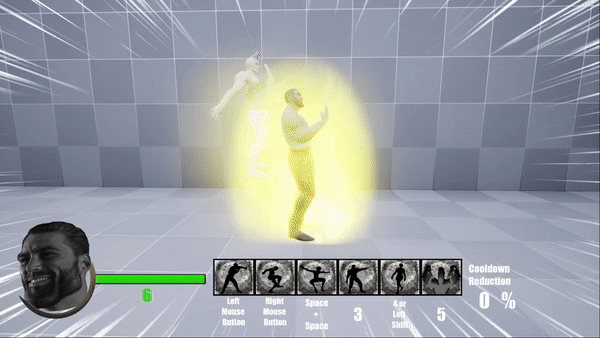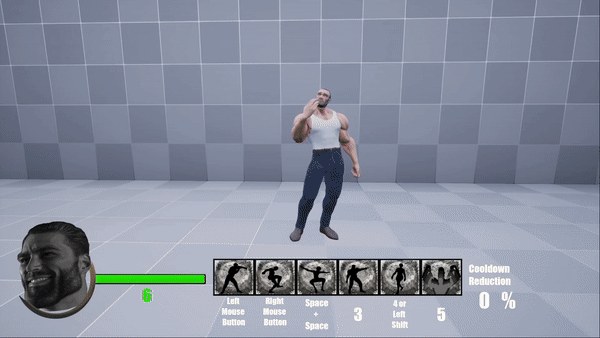The Chad (Steam Launch)
Production Time | 4 months Time Frame | Summer, Fall 23' Team Size | 3
Play Time | 1 - 2 Hours
Trailer
Full Gameplay Walkthrough
The Chad is a humorous action game based on memes.
I was the design owner on the gameplay and levels. I worked on levels, finding the fun, player abilities, and most of the features within the game.
The game is on Steam and Itch.io
Level Design and Technique Breakdown
Level 1: Hard Gating
The player is hard gated, or stopped from progressing, by a pair of trucks in level 1. They are conditioned to explore and find the first ability in order to move these trucks and progress. Throughout the game the player is hard and soft gated until they find the next new ability which will provide them the capacity overcome various obstacles.
Level 2: Visual Language
In the game various objects are highlighted in specific colors to convey that they are associated with other objects. There are many shrine encounters throughout the game where the player must use abilities to launch explosive barrels at the shrines to destroy them. However, different colored barrels require specific abilities, do various amounts of damage, and will only do damage to shrines with their correlating color.
Level 3: Teasing and Signposting
In level 3, important objects are visible yet out of the player's reach forcing them to explore and pick them up later. Literal signs and graffiti decals are used in order to guide the player in a diegetic and non intrusive manner.
Level 4: Landmarks
Halfway through level 4, the map opens up creating a vast open space for the player to explore. In order to provide the player with reference to where they are, 2 macro landmarks are positioned at where the player starts in the space and to where the final encounter and level end is.
Level 5: Breadcrumbing
Throughout the game there are several pick ups that provide resources like healing, health, and speed buffs. During level 5 the player has to use the strut ability to cross over water and in order to continue strutting the player must pick up the powder jars to recharge the ability's duration. The pick ups help to guide the player to the different islands with a little touch of framing to point the player in the right direction.
Finding the Fun
In the game's original demo, the gameplay was simple and not as engaging as it could be. Over time, I came up with new, fun ways to enhance the gameplay and progression with changes to the loop and with addition to new features, many of which I executed on and owned.
Gameplay Loop
One of the issues with earlier gameplay was a lack of a meaningful and rewarding objective. I decided to come up with a new loop, level structure, main combat encounter. In order to achieve this, I worked with the team to create shrine spawners that rewarded the player with reduced ability cooldown when destroyed. This would provide a new challenge, but also tie in with the humor and absurdity of the game.


Feature Iteration
Explosive Barrels - Barrels that can be launched at enemies, obstacles, statues, and shrine spawners to explode and deal damage. Certain shrines can only take damage from specific barrel types based on their color. Barrel types deal different amounts of damage to shrines.
-
Not only do the barrels give the player more fun options in combat, but they also add an additional element of extrinsic and intrinsic progression to the experience through their primary usage in shrine encounters.
Statue Hazards - Statues that deal damage in an AOE to the player when they are near by. They can only be destroyed with explosive barrels.
Originally, the barrels were damage hazards to the player. I scripted their explosive functionality to where the player could deactivate their AOE damage then activate their explosion to use against enemies. However, it was too much of a conflict of functionality and the hazard established a strong negative feedback that made players very hesitant to utilize them as a combat option. Instead, I created the statues to be hazards instead which added to the absurdity of the game experience while fixing the issue.

Iteration, Early Prototypes, and Demo
For the first two months of development, this game was a two man team where I was responsible for all of the game's design and scripting. During this time, I iterated on our primary level, scripted all of the game's features, and developed the gameplay.
2nd Playable
Our second playable build after about a week of development and also our first tested build. The major conclusion for this build was that the game's objective was too complicated, which promoted me to pivot the game mode.
Early Prototype
An early prototype build where I developed many of the core abilities and established the new gameplay objective of finding other lifters throughout the map.
Later Prototype
We continued to develop a few more builds where I added new features and fixed bugs. I gave the female enemy a long range attack to help differentiate them from the male enemies. I also worked on the UI elements and iterated on the player inputs.
Pre Demo
At this point, a lot of the game art assets where coming in and I developed many new areas of the map including secret areas within the town but also the beach area of the map. This was when I also started work on the early version of the save system and the menu screen.
Demo
The final sprint to the demo build had me focused on finalizing the level design for the game where I created a new island section where the play could use the strut ability to walk on water. The demo level would reflect greatly into the design of levels 4 and 5 of the final launch build.
Ability Design
Overview: I originally scripted out a few different player abilities and pick ups with cooldowns and placeholder UI. Over time, I iterated on what the abilities could do based on personal, team, and playtesting feedback. Important aspects that I iterated on were the combat frames (wind up, active, recovery), animation speeds, sfx, vfx, base cooldowns, and order of acquirement. Not only did I do this for the player character but also for the AI and for all sfx, vfx, and the post processing in the game.
Some other major changes added to some of the abilities were an AOE knock back represented by the circular cloud vfx and removing I frames, invincibility. This helped to balance combat in a way that was more fair based on player feedback. The UI art and tool tips were created by Michael Falcone, the solo artist on the project.
Ability 1: Punch
Originally the punch was much slower. Due to feedback, I have made the punch much faster with minimal cooldown to act more like an auto attack and less like an ability.



Ability 2: Stomp
Eventually, I added the capacity to knock up explosive barrels with the stomp and then launch them to explode with the punch as a combo. This felt fun and more engaging then just punching barrels to make them explode.


Ability 3: Jump Slam
In original builds of the game, this ability was only a jump to evade attacks and jump over obstacles to unlock new areas. Eventually, I added the slam so this ability could also be used offensively.


Ability 4: Stand Power
This ability was originally called the flex and only did an AOE stun. Over iterations, I gave it the capacity to 'change reality' by making certain objects appear and re appear. This afforded the player new paths in the level and changed areas of cover in shrine combat encounters.
Patch 1: I made the Stand Power post process more simple as the inverted colors provided issues with visibility. I also took time to condition the ability more thoroughly to showcase the new affordances it provides to the player.


Ability 5: Strut
The strut was a pleasant surprise to many early playtesters as I would introduce water in the level then provide them this ability to walk on it to unlock new areas.


Ability 6: Giga Mode
The first iteration of this ability was as a limited time pick up where the character model just scaled up and was invincible during the duration. Now it is used in the final encounter to make the player feel powerful and has a character model change.


